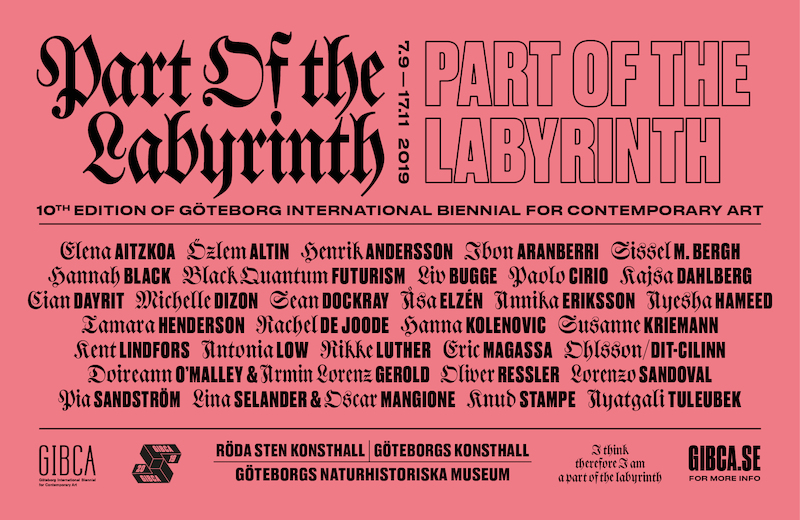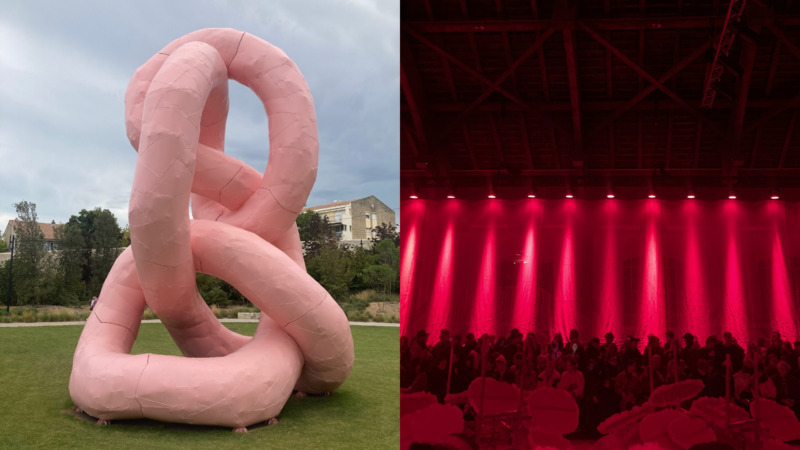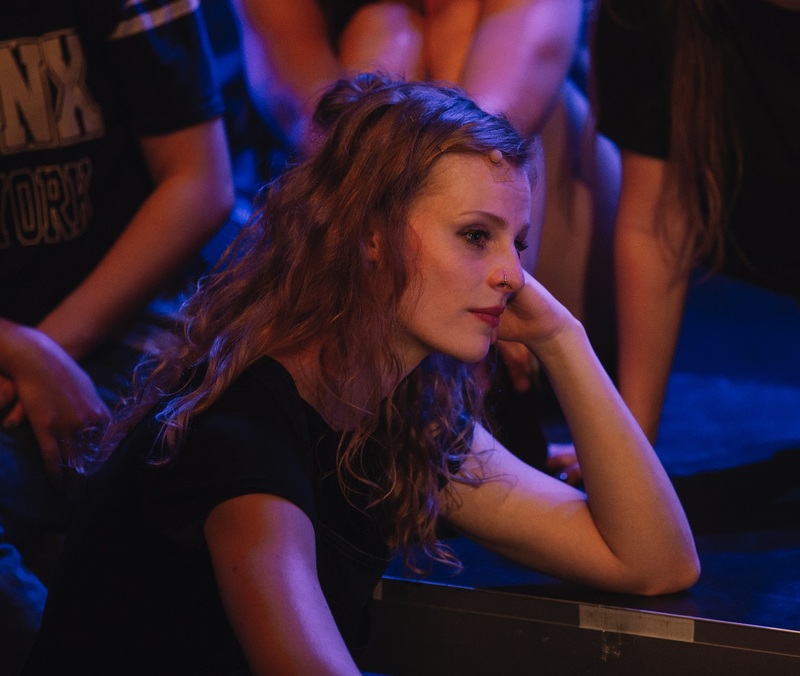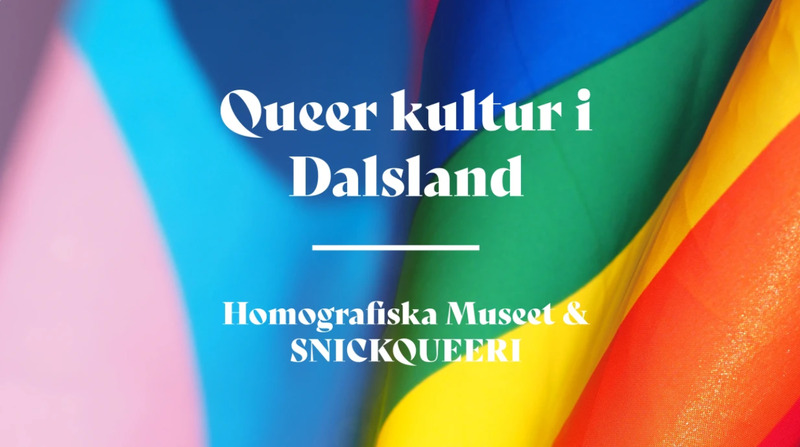
Bild: Göteborg International Biennial for Contemporary Art (GIBCA)
Krönika
Meeting a City Through Its Art Biennial
Publicerat 2019.08.30
- Branschspaning
- Göteborg
- Konst
It’s late August 2019 and just a few days left to the opening of the 10th edition of Göteborg International Biennial for Contemporary Art (GIBCA). An art exhibition is being weaved between Röda Sten Konsthall, Göteborgs konsthall, Gothenburg Museum of Natural History and public spaces in the city, at Packhusplatsen and in Haga. Artworks are produced in Gothenburg or head here from all around the world, technicians are building exhibitions overnight, pedagogues are testing out workshops for children and adults, a newspaper is in print and will soon reach 40 000 households in Gothenburg.
In these intense days before the vernissage on September 7, I will take a moment to look back at the two years preparation process that an art biennial implies. We will look behind the stages of the international art exhibition scouting for locations for artworks, we will accompany artists in discovering the histories of our city and we will travel in time to understand the city’s present and we consider Gothenburg’s part on the international art scene. And at the end of this text journey, I hope to inspire you to join me and the dedicated team working with the project at Röda Sten Konsthall for the opening of the biennial and the exciting public programme we prepared for this autumn.
To start from the very beginning, we jump back in time to 2001, the year Wikipedia was launched, redefining how we relate to knowledge and information, and the year the biennial was initiated by the Cultural Committee of the City of Gothenburg. It was a moment in time when many cities in Europe founded art biennials, driven by an interest in international cultural exchange and in search of decentralisation of the cultural scene. Now, almost twenty years after, biennials are considered some of the most interesting events in the global cultural calendar.
Biennials at large are also a reflection on currents and trends within the art world and benefit from the interest of international press and professionals in the field, thus making their hosting cities an attractive destination. Currently there are approximately 300 biennials around the world. Amongst them, Göteborg International Biennial for Contemporary Art is a medium-size context-specific project, with international visibility and prestige.
The biennial produces new artworks connected to stories and histories in Gothenburg and West of Sweden for every edition and aims to be an important junction between the local, national and international art practitioners. At the same time, the biennial promotes Gothenburg as a specific centre for the production and display of contemporary art. While putting Gothenburg on the international map of contemporary art, the biennial has also introduced to Sweden numerous acclaimed artists, presented remarkable Swedish artists, and has engaged with people, stories and places in Gothenburg for memorable art presentations on globally relevant questions.
To each of its editions, the biennial invites one or several curators to enter in a dialogue with the city of Gothenburg. And it is the first steps of this dialogue with the city that I as artistic director am enjoying most. The first months of working with a new curator are always an occasion to meet the city anew. It is the months in which an imaginary map of stories, archive documents, meetings, is drawn in order to identify the theme or the questions for the next biennial project. In this period all possibilities are open and the work with the art exhibition is similar to a laboratory one. We travel the city north to south and east to west for new exhibition venues, we visit artists in their studios in Gothenburg, we meet in dialogue representatives of the community and of local institutions. We get to find out stories of the city’s past, present and possible future and so many amazing people in Gothenburg share their knowledge with us.
I’ve been working with the biennial project from 2017 and, as a recent “göteborgare” myself, have had the privilege to meet the city through fantastic professionals, and grew attached to it with every art project we initiated and made happen. Stories of Gothenburg’s many churches, mosques and places of worship, meetings with art in second hand shops, hearing invisible histories of the city’s parks, visits to surprising food markets, searching in the incredible collection of the University Library and a study of store fronts in Gothenburg are just a few of the unexpected encounters for the biennial in 2017.
In 2019 we’ve got to know more about the city’s historical centre and its many historical layers, from Haga to Packhusplatsen, its connection to global histories of trade, colonisation and industry. We went in the construction tunnels for Västlänken, we found the perfect tree-root to become an artwork, we discovered the stories of the starfish in the collection of the Natural History Museum, searched for postcards of historical Gothenburg and collected stories of Västra and Östra Nordstan. Between September-November we look forward to sharing more of our findings with you and to introduce you to the artists and artworks that brought us to these expeditions.
The invisible work behind exhibitions is often kept aside from the magic of the vernissage: the artworks are given the central stage disconnected from their context. I believe that making the processes behind a long-term art project like the biennial visible, the path from ideas to reality, can change the way we think about contemporary art and can reshape the resources, be it time or capital, we are willing to assign to it.
For many months during the year, the biennial team assists the artists in the production of new works and coordinates art loans and art transport from all world’s ends. We seek international partnerships and funding support for our project to make our project grow. At the same time we meet professionals in the region that are active outside the art sphere, to know more about the questions and themes the curator proposes for the coming biennial. We welcome artists in residence in our city and match them with artists and craftsmen interested in similar topics or working with similar techniques.
We also take time to meet our branch colleagues and we organise several meetings a year with institutions and artists active in Västra Götaland, nurturing the spirit of collaboration and exchange that made the biennial thrive throughout its many editions.
A result of the enthusiasm and support of many local and regional stakeholders and being a project dedicated to local and international audiences, the biennial is implemented from 2006 by Röda Sten Konsthall, an independent art centre, and is funded by Göteborg Stad and Västra Götaland region.
Göteborg biennial facilitates international and regional cooperation as we are interested in nurturing dialogue within the arts and aware of our need to position internationally among the 300 other biennial. GIBCA promotes diversity and innovative curatorial practices and education formats as an initiator of an international professional network with biennials in Belgium, Ireland, Norway and of the open regional network GIBCA Extended.
The biennial is also interested in the local specificity of the art sector, the amazing artist-run initiatives that dominate the Gothenburg cultural landscape, and seeks to introduce international professionals to the local contemporary art actors.
This year the biennial celebrates its tenth edition, an occasion to test a new format and encourage long-term commitment to a theme, artists and audiences. Having in mind also the coming anniversary of 400 years of the City of Gothenburg in 2021, GIBCA has invited Lisa Rosendahl to curate the biennials in 2019 and 2021, allowing more time for projects to form and conversations to arise. The Gothenburg biennial strives for sustainable engagement and tries to avoid the logic of supra-production and rapid encounters that the global art market and art fairs encourage.
Rosendahl, a Swedish curator based in Berlin, worked extensively with research on industrial societies in Sweden, as Gothenburg is an example of. Between 2018-2021, she will invite artists to engage with stories and histories in Gothenburg and reflect on the perspectives brought by the last 400 years on a global scene.
The biennial in 2019, titled Part of the Labyrinth, uses interconnectedness as both motif and method, addressing the consequences of a world dominated by ideas of autonomy and separation– of genders, species and continents, as well as nature and technology, economy and the environment etc. In times of imminent environmental catastrophes, the biennial invites to new ways to read the world: only by recognising how we are deeply interconnected with, and dependent on each other and our surroundings, will change become possible.
The biennial exhibition is in 2019 taking place at Gothenburg Natural History Museum, Röda Sten Konsthall, Göteborgs konsthall and Franska tomten (Packhusplatsen) and presents works of 35 artists. The public program consists of artist talks, debates, film screenings at institutional and non-institutional venues around the city.
We await the public with 30 programmes in 72 days, with more than 100 school classes, and tens of guided tours and workshops at each exhibition venues. We hope our biennial art project will help you discover the city anew and inspire to interesting conversations.
-
Ioana Leca, artistic director Göteborg International Biennial for Contemporary Art
-
Tips! I invite you to discover the biennial also through its new app, GIBCA (free for download in App store), where you can read more about the artworks on show and the themes brought up.
Two of the artworks presented in the biennial are available in the app only!



